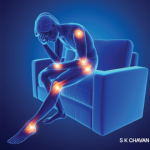Autoinflammatory syndromes that are not monogenic and autoinflammatory diseases with complex genetic traits: This spectrum has been growing and is claimed to include diseases such as Behçet Disease, systemic juvenile idiopathic arthritis.18
Management Principles and Prognosis
The use of colchicine has been a breakthrough in the management of FMF. This is the only periodic fever where an excellent quality of life is possible in the majority of patients—and with a cheap pill. In fact, colchicine has been shown to prevent amyloidosis in compliant patients in series from Israel and Turkey.19,20 In a large pediatric study (n=809), no manifestations of amyloidosis occurred in 809 treated children during an observation period of up to 13 years.19 In the Turkish FMF registry, 2.3% developed amyloidosis, all being noncompliant with respect to regular colchicine intake.20 We do not know the genetic factors that determine the development of secondary amyloidosis, although a number of polymorphisms in relevant genes have been associated with the development of secondary amyloidosis in FMF.
A starting dose of 0.5 mg/day colchicine in young children and 1.0 mg/day in older children (older than five years) is sufficient for disease control in approximately half of patients.21 This is increased to 1.5–2 mg/day once the child is more than a square meter. SAA levels might indicate insufficient disease control and thereby require dose adjustment.22
As physicians, we should warn the families about the risk to other children and follow patients’ siblings closely for any symptoms of unexplained fever or typical attacks. A routine mutation analysis of the FMF gene for siblings is probably not indicated. However, if there is a case of renal amyloidosis in the family, a genetic workup may be informative. SAA levels may need to be checked in patients with one mutation only and in siblings.
Dr. Ozen is professor of pediatrics at Hacettepe University in Ankara, Turkey.
References
- Livneh A, Langevitz P. Diagnostic and treatment concerns in familial Mediterranean fever. Baillieres Best Pract Res Clin Rheumatol. 2000;14(3):477-498.
- Stojanov S, Kastner DL. Familial autoinflammatory diseases: genetics, pathogenesis and treatment. Curr Opin Rheumatol. 2005;17(5):586-599.
- Ozen S. Familial mediterranean fever: revisiting an ancient disease. Eur J Pediatr. 2003;162(7-8):449-454.
- Aksentijevich I, Torosyan Y, Samuels J, et al. Mutation and haplotype studies of familial Mediterranean fever reveal new ancestral relationships and evidence for a high carrier frequency with reduced penetrance in the Askhenazi Jewish population. Am J Hum Genet. 1999; 64: 949-962.
- Samuels J, Ozen S. Familial Mediterranean fever and the other autoinflammatory syndromes: Evaluation of the patient with recurrent fever. Curr Opin Rheumatol.2006;18:108-117.
- Yilmaz E, Ozen S, Balci B, et al. Mutation frequency of Familial Mediterranean Fever and evidence for a high carrier rate in the Turkish population. Eur J Hum Genet. 2001; Jul; 9(7):553-555.
- Chae JJ, Wood G, Masters SL, Richard K, et al. The B30.2 domain of pyrin, the familial Mediterranean fever protein, interacts directly with caspase-1 to modulate IL-1beta production. Proc Natl Acad Sci U S A. 2006 Jun 27;103(26):9982-9987.
- Livneh A, Langevitz P, Zemer D, et al. The changing face of familial Mediterranean fever. Semin Arthritis Rheum. 1996;26(3): 612-627.
- Tunca M, Akar S, Onen F, et al. Familial Mediterranean fever (FMF) in Turkey: results of a nationwide multicenter study. Medicine (Baltimore). 2005;84(1):1-11
- Ozen S, Bakkaloglu A, Yilmaz E, et al. Mutations in the gene for familial Mediterranean fever: do they predispose to inflammation? J Rheumatol. 2003 Sep;30(9):2014-2018.
- Lachmann HJ, Sengul B, Yavuzsen TU, et al. Clinical and subclinical inflammation in patients with familial Mediterranean fever and in heterozygous carriers of MEFV mutations. Rheumatology. 2006; 45(6):746-750
- Livneh A, Langevitz P, Zemer D, et al. (1997) Criteria for the diagnosis of FMF. Arthritis Rheum.1997;40:1879-1885.
- Hoffman HM, Rosengren S, Boyle DL. et al. Prevention of cold-associated acute inflammation in familial cold autoinflammatory syndrome by interleukin-1 receptor antagonist. Lancet. 2004;364(9447): 1779-1785.
- Neven B, Callebaut I, Prieur AM, et al. Molecular basis of the spectral expression of CIAS1 mutations associated with phagocytic cell-mediated autoinflammatory disorders CINCA/NOMID, MWS, and FCU. Blood. 2004;103:2809-2815
- Drenth JP, Cuisset L, Grateau G, et al. Mutations in the gene encoding mevalonate kinase cause hyper-IgD and periodic fever syndrome. International Hyper-IgD Study Group. Nat Genet. 1999;22(2):178-181.
- Frenkel J, Houten SM, Waterham HR, et al. Clinical and molecular variability in childhood periodic fever with hyperimmunoglobulinaemia D. Rheumatology (Oxford). 2001 May; 40(5):579-584.
- McDermott MF, Aksentijevich I, Galon J, et al. Germline mutations in the extracellular domains of the 55 kDa TNF receptor, TNFR1, define a family of dominantly inherited autoinflammatory syndromes. Cell.1999; 97(1):133-144.
- Ozen S, Hoffman HM, Frenkel J, Kastner D. Familial Mediterranean fever (FMF) and beyond: a new horizon. Fourth International Congress on the Systemic Autoinflammatory Diseases held in Bethesda, USA, 6-10 November 2005. Ann Rheum Dis. 2006; 65(7):961-964.
- Zemer D, Livneh A, Danon YL, Pras M, Sohar E. Long-term colchicine treatment in children with familial Mediterranean fever. Arthritis Rheum. 1991 Aug;34(8): 973-977.
- Saatci U, Ozen S, Ozdemir S, et al. Familial Mediterranean fever in children: report of a large series and discussion of the risk and prognostic factors of amyloidosis. Eur J Pediatr. 1997; 156(8):619-623.
- Kallinich T, Haffner D, Niehues T, et al. Colchicine use in children and adolescents with familial Mediterranean fever: literature review and consensus statement. Pediatrics. 2007;119(2):474-483.
- Berkun Y, Padeh S, Reichman B, et al. A single testing of serum amyloid a levels as a tool for diagnosis and treatment dilemmas in familial Mediterranean fever. Semin Arthritis Rheum. 2007;37:182-188.



